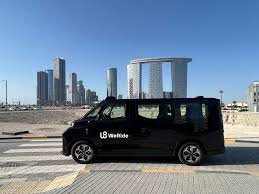Dubai, UAE – The future of urban transport in the Middle East is taking a bold leap forward. Dubai’s Roads and Transport Authority (RTA) has announced a landmark agreement with Uber and China’s autonomous vehicle company, WeRide Inc., to begin pilot robotaxi operations in the city later this year. Residents and visitors alike will soon be able to book autonomous rides via the Uber app — a groundbreaking shift in how Dubai moves.
Pioneering Dubai’s Autonomous Transport Vision
The announcement follows months of anticipation after Uber and WeRide first teased their partnership with the RTA in April. Now, the roadmap is clear: Dubai’s streets will see WeRide’s robotaxis in action by the end of this year, initially operating with safety drivers onboard as a transitional measure.

This milestone project directly supports the Dubai Smart Self-Driving Transport Strategy, an ambitious plan to convert 25% of all transportation in the emirate into autonomous journeys by 2030. It marks another confident step in positioning Dubai as a global leader in future mobility solutions.

Pilot Launch Timeline and Operational Phases
The rollout will unfold in multiple phases. In the first stage, scheduled for late 2025, WeRide’s autonomous vehicles will begin operating under pilot status. Each robotaxi will be equipped with a human safety driver to monitor and take control if necessary.
If this trial phase progresses smoothly, the plan is to launch full-scale commercial driverless operations by 2026, making Dubai one of the first cities globally to offer a commercial autonomous ride-hailing service through a major platform like Uber.
Field preparations for this pilot program are already underway. Uber and WeRide’s engineering and operations teams are collaborating closely with the RTA to establish route testing, safety protocols, and customer experience standards in anticipation of this public-facing trial.
WeRide’s Momentum and Global Expansion
WeRide’s entry into Dubai’s autonomous vehicle scene follows a successful commercial launch in Abu Dhabi in December 2024, where the company introduced fully driverless AV services through the Uber app. That rollout marked a major breakthrough in the region’s embrace of autonomous mobility and set the stage for this Dubai debut.
Beyond the UAE, WeRide and Uber have announced a strategic plan to expand their robotaxi partnership to 15 additional cities over the next five years. These new markets will primarily be located outside the United States and China, with a strong focus on the Middle East and Europe. The companies believe this international expansion will play a key role in driving the future of autonomous ride-hailing.
WeRide’s Stock Surge on Nasdaq
Investor sentiment around WeRide has soared in tandem with these developments. On Monday, the company’s Nasdaq-listed shares (WRD) climbed more than 3% at midday, breaching the $6 mark for the first time in recent months. The stock’s rise reflects growing confidence in WeRide’s international strategy, as well as the wider appeal of autonomous vehicle technology in high-growth, innovation-friendly markets like the UAE.
While the company continues to operate at a net loss, WeRide’s leadership remains optimistic. The recent string of successful launches, strong regional government partnerships, and rising demand for next-generation transport solutions is steadily strengthening the company’s market position.

Why Dubai’s Move Matters Globally
Dubai’s push to integrate robotaxis into its daily transport services isn’t just about convenience; it’s about setting a global example. As one of the world’s most progressive smart cities, Dubai’s investment in autonomous mobility technologies showcases how public-private partnerships can fast-track the future of urban transportation.
This move also highlights the UAE’s growing importance as a testbed for emerging technologies, offering an attractive regulatory environment, infrastructure investment, and public enthusiasm for innovation. With multiple robotaxi makers now eyeing the Gulf region, Dubai’s proactive stance ensures it remains ahead of the curve.
For Uber, the Dubai rollout reinforces its strategy of becoming a global aggregator of autonomous vehicle services. Instead of building its own driverless car technology from scratch, Uber has strategically partnered with leading AV providers like Waymo, Motional, and now WeRide. This diversified approach allows Uber to offer AV services across different markets while focusing on its core strength — providing seamless, tech-driven ride-hailing experiences for customers.
A Glimpse Into the Future of Ride-Hailing
The Dubai pilot program is poised to serve as a proof of concept for large-scale urban AV deployments. If successful, it could redefine how ride-hailing services operate in densely populated cities, offering safer, more efficient, and environmentally friendly transport alternatives.
Moreover, the prospect of driverless taxis raises important conversations about public safety, passenger experience, job displacement, and new regulatory frameworks. Uber, WeRide, and the RTA are actively working together to ensure that these issues are addressed proactively, with rigorous safety measures, customer education initiatives, and carefully phased rollouts.
Investor and Market Outlook
WeRide’s rising stock performance is reflective of investor appetite for tangible AV projects with government backing and clear commercial pathways. As other players like Tesla, Waymo, and Baidu continue advancing their autonomous programs, WeRide’s strategy of focusing on non-U.S., high-growth markets is attracting attention.
With Abu Dhabi already online and Dubai joining later this year, analysts anticipate sustained stock momentum if these services achieve positive customer adoption and operational milestones. The planned expansion to 15 new cities over five years adds further upside potential.

What’s Next
For everyday residents and visitors to Dubai, this means that by the end of this year, robotaxis will no longer be a futuristic concept, but a practical option via the Uber app. The first rides may have a safety driver upfront, but they will still offer a fascinating glimpse into a world where cars drive themselves.
If all goes according to plan, 2026 will see driverless vehicles cruising Dubai’s streets — ushering in a new chapter for the city’s world-renowned transport network.
At the same time, global cities and tech investors alike will be closely watching Dubai’s rollout, eager to see how this cutting-edge technology integrates with real-world urban mobility.
Conclusion
Dubai’s partnership with WeRide and Uber isn’t just a local project; it’s a symbol of the rapid progress being made in autonomous transportation worldwide. As WeRide continues its global expansion, backed by successful regional launches and rising investor confidence, the company is steadily carving out its place as a leader in the robotaxi revolution.
With stock prices climbing and bold plans on the horizon, WeRide’s story is one to watch — and for Dubai’s residents, the future of transportation is arriving faster than anyone might have predicted.
Do follow UAE Stories on Instagram.
Dubai Marina fiery blaze: A Wave of Kindness Sweeps Through the City













